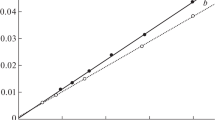Summary
In the first two parts of the series on quantitative procedures in thin layer chromatography, after a survey of the available methods and the general conditions for quantitative thin layer chromatography, those procedures are discussed which are suitable for direct determination of compounds showing absorption in the visible or UV range, i.e. methods for determining spot areas, densitometry, and remission measurements.
In favorable cases, spot area determinations provide useful results with a minimum of expense. The most precise results are achieved with remission measurements (standard deviation 3–7% relative), but only when the chromatogram sample and reference spots of approximately comparable concentration can be compared with each other. In all procedures based on light absorption measurements, the size and shape of the spots, distribution of the compound in the layer, and numerous other parameters, have a considerable influence on the measured result, and it is only in this way that they can be kept sufficiently precise and constant for routine measurements.
Zusammenfassung
In den beiden ersten Folgen der Artikeireihe über quantitative Verfahren in der Dünnschicht-Chromatographie werden nach einem Überblick über die zur Verfügung stehenden Methoden und den allgemeinen Voraussetzungen der quantitativen Dünnschicht-Chromatographie diejenigen Verfahren besprochen, die zur direkten Bestimmung im Sichtbaren oder im UV absorbierender Substanzen geeignet sind, also die Methoden zur Bestimmung von Fleckenarealen, die Densitometrie und die Remissionsmessungen.
Mit geringsten Hilfsmitteln liefern in günstigen Fällen Fleckenarealbestimmungen brauchbare Ergebnisse. Die genauesten Ergebnisse sind durch Remissionsmessungen zu erzielen (Standardabweichung 3–7% relativ, jedoch nur unter der Voraussetzung, daß jeweils auf demselben Chromatogramm Meß- und Vergleichsflecke annähernd gleicher Konzentration miteinander verglichen werden. Bei allen Verfahren, die auf Lichtabsorptionsmessungen beruhen, haben Fleckengröße und Form, Verteilung der Substanz in der Schicht und zahlreiche weitere Parameter einen erheblichen Einfluß auf das Meßergebnis, die bei Routinemessungen nur auf diese Weise genügend genau konstant gehalten werden können.
Sommaire
Dans les deux premières parties de cette série de travaux sur des procédés quantitatifs de chromatographie en couche mince, après avoir passé en revue les méthodes disponibles et les conditions générales de chromatographie quantitative sur couche mince, on a décrit les procédés qui permettent la détermination quantitative directe des substances absorbant la lumiére visible ou ultraviolette, c'est-à-dire les méthodes utilisant la détermination de la surface des taches, la densitométrie, et la mesure de réémission.
Dans des cas favorables, les déterminations des surfaches des taches fournissent des résultats valables avec un minimum de moyens. Les résultats les plus précis sont obtenus par des mesures de réémission (déviation standard relative 3–7%), à condition d'avoir sur le même chromatogramme des taches à mesurer et des taches de référence de concentrations à peu près égale afin de permettre leur comparaison. Dans tous les procédés basés sur la mesure de l'absorption de la lumière, la largeur et forme des taches, la distribution de la substance dans la couche, et de nombreux autres paramètres ont une influence considérable sur le résultat de la mesure; c'est seulement en tenant compte de ces paramétres qu'on peut obtenir des résultats suffisamment précis et constants pour les mesures de routine.
Similar content being viewed by others
Literatur
1. Folge:Seiler, N. undH. Möller, Chromatographia2, 273 (1969).
Krebs, K. G., D. Heusser undH. Wimmer, in: „Dünnschicht-chromatographie”, Hrsg. E. Stahl, Springer Verlag, Berlin, Heidelberg, New York, 2. Aufl. S. 813, 1967.
Moczar, E., M. Moczar, G. Schillinger undL. Robert, J. Chromatog.31, 561 (1967).
Lamkin, W. M., D. N. Ward undE. F. Walborg, Jr., Analyt. Biochem.17, 485 (1966).
Hara, S., H. Tanaka undM. Takeuchi, Chem. Pharm. Bull. (Japan)12, 626 (1964).
Attaway, J. A., R. W. Wolford undG. J. Edwards, Analyt. Chem.37, 74 (1965).
Semenuk, G. undW. T. Beher, J. Chromatog.21, 27 (1966).
Zöllner, N., G. Wolfram undG. Amin, Klin. Wschr.40, 273 (1966).
Neskovic, N. M., J. Chromatog.27, 488 (1967).
Poethke, W. undW. Kinze, Pharmaz. Zentralhalle103, 577 (1964).
Husain, S. undP. A. Swaroop, J. Chromatog.22, 180 (1966).
Blunden, G. undR. Hardman, J. Chromatog.34, 507 (1968).
Shellard, E. J. undM. Z. Alam, J. Chromatog.33, 347 (1968).
Joyce, Loebl & Comp. Gateshead on Tyne, (England).
Klaus, R., J. Chromatog.16, 311 (11964).
Blunden, G., R. Hardman undJ. C. Morrison, J. Pharm. Sci.56, 948 (1967).
Kubelka, P. undF. Munk, Z. Techn. Phys.12, 593 (1931).
Kubelka, P., J. Opt. Soc. Am.38, 448 (1948).
Kortüm, G. undD. Oelkrug, Naturwiss.53, 600 (1966).
Kortüm, G., W. Braun undG. Herzog, Angew. Chem.75, 653 (1963).
Kortüm, G., J. Vogel undW. Braun, Angew. Chem.70, 651 (1958).
Kortüm, G. undV. Schlichenmaier, Z. Phys. Chem.48, 267 (1966).
Frei, R. W. undH. Zeitlin, Analyt. Chim. Acta32, 32 (1963).
Stahl, E. undH. Jork, Zeiss Informationen68, 52 (1968).
Frodyma, M. M. undD. J. Williams, J. Chromatog.13, 61 (1964).
Frodyma, M. M. undR. W. Frei, J. Chromatog.15, 501 (1964).
Frodyma, M. M., V. T. Lieu undR. W. Frei, J. Chromatog.18, 520 (1965).
Frodyma, M. M. undV. T. Lieu, Analyt. Chem.39, 814 (1967).
Frei, R. W. undN. S. Nomura, Mikrochim. Acta1968, 565.
Levita, B., Zeiss Informationen68, 45 (1968).
Carl Zeiss, Oberkochen, (Deutschland).
Hamman, B. L. undM. M. Martin, Analyt. Biochem.15, 305 (1966).
Vitatron, Dieren, (Holland).
De Galan, L., J. Van Leeuwen undK. Camstra, Analyt. Chim. Acta35, 395 (1966).
Gordon, H. T., J. Chromatog.22, 60 (1966).
Jänchen, D. undG. Pataki, J. Chromatog.33, 391 (1968).
CAMAG, Muttenz, (Schweiz).
Jork, H., J. Chromatog.33, 297 (1968).
Jork, H., Z. analyt. Chem.221, 17 (1966).
Braun, W. undG. Kortüm, Zeiss Informationen67, 27 (1968).
Kortüm, G. undJ. Vogel, Angew. Chem.71, 451 (1959).
Klaus, R., J. Chromatog.34, 539 (1968).
Author information
Authors and Affiliations
Rights and permissions
About this article
Cite this article
Seiler, N., Möller, H. Quantitative Verfahren in der Dünnschicht-Chromatographie 2. Folge [1]. Chromatographia 2, 319–324 (1969). https://doi.org/10.1007/BF02258971
Issue Date:
DOI: https://doi.org/10.1007/BF02258971




